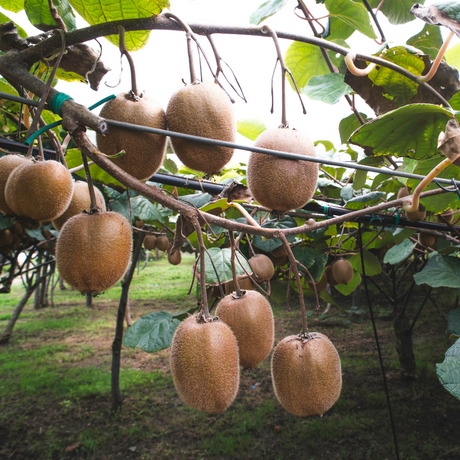- €10,86Unit price /Unavailable
Dwarf fig tree 'Little Miss Figgy' BIO
€27,72Unit price /Unavailable- €32,68Unit price /Unavailable
Vidéo
Watch Ruud's video about citrus here.
Our other soft fruit
View allBuy a Fig Tree: Mediterranean Convenience with Fruits in a Pot
A potted fig tree is not only beautiful but also practical. A fig tree is easy to maintain as a potted plant, making it easy to move and protect from frost. It fits on your patio, balcony, or in the garden, requires little to no water, and produces delicious fruit. And all of this in a stylish, compact form. The fig tree is a true Mediterranean tree with a Mediterranean appearance, and it thrives as a potted plant. At Plukkers, you can choose from strong, productive fig varieties that thrive in both pots and in the ground.
Why a fig tree ( ficus carica ) in a pot?
Figs are surprisingly easy-care plants. They love warmth, but they're hardier than you might think. A pot allows you to always choose the best location for your fig tree. Especially in a pot, you can easily protect them from the cold and give them exactly the spot they deserve. Fig trees can be ordered year-round, but may not be in stock during the winter. Fig trees can be delivered to your home within 1 to 2 business days.
The fig tree grows best in a spot in full sun or partial shade. It is also well-suited to the Dutch climate and can withstand Dutch weather conditions. For optimal growth, the fig tree should be placed in a sheltered spot in full sun or partial shade. The Ficus carica (fig tree) is native to western Asia.
The benefits:
- Easy to move in frost
- Compact, yet productive
- Delicious fresh figs from your own pot
- Atmospheric plant with decorative leaves
- Suitable for garden, terrace and balcony
- Winter hardy and resistant to the Dutch climate
- Often with multiple trunks for an extra decorative effect
- Can tolerate temperatures down to about -10°C
- The Brown Turkey fig tree is winter hardy and suitable for the Dutch climate
Our winter-hardy fig trees in pots
Brown Turkey: Organic Fig Tree 'Brown Turkey' – 2L pot
A hardy, self-pollinating variety known for its sweet, juicy fruits. Suitable for Dutch summers, the fruit usually ripens in August or September. You can tell a fig is ripe when the fruit splits or cracks, which is a sign that it's ready to pick. Figs are ripe when they feel soft and easily come off the tree. It grows compactly and often produces two harvests per year. A fig tree can reach a height and width of 2.5 to 3 meters, depending on its location and pruning. The fig tree can be full of edible fruits that can ripen in our climate with sufficient sun.
Dwarf fig 'Little Miss'
Small but mighty. This dwarf variety is ideal for balconies or small city gardens. It grows slowly, remains compact, and produces edible figs with a sweet flavor. When repotting the dwarf fig, it's important not to damage the root ball and to ensure the pot is large enough to accommodate it. When planting in a pot, using hydroponic clays for drainage is recommended. A fig tree can also be planted in a container.
Fig tree location
The right spot for your fig tree (Ficus carica) is truly half the battle for a healthy and productive tree. Always choose a nice sunny spot where your fig tree gets at least six hours of sun a day – you'll be amazed at how the fruit will ripen optimally and reward you with a delicious harvest. A sheltered spot, for example against a warm wall, is invaluable as it protects your hardy fig tree from cold winds and severe frost. If you're planting your fig tree in the ground, dig a large hole about 30 cm deep so the roots can spread out nicely – your tree will thank you. Ensure good drainage to prevent wet feet, as fig trees really don't like wet soil (just like us, by the way). Prefer to plant your fig tree in a pot? Then choose a spacious pot with plenty of drainage holes so excess water can drain easily. Use hydroponic clays and a Mediterranean substrate for optimal drainage. Fig trees in the ground need less water than those in pots. This gives your ficus carica the best start for healthy growth and a beautiful Mediterranean look in your garden or on your patio – enjoy your new green friend!
Pruning a fig tree
Pruning is really important for keeping your fig tree in good shape and ensuring you can enjoy delicious figs later. Early spring, before you see the new buds emerging, is the perfect time to take a moment to enjoy it. Simply cut away those long shoots and branches that are growing tangled together—this keeps your tree airy and gives it a beautiful shape. Also check for dead wood and diseased branches: it's best to cut these away completely, so your tree can continue to grow healthily. Regular pruning keeps your fig tree compact and vigorous, so you can enjoy fresh figs from your own garden every year. Remember to always use clean, sharp tools—your tree will thank you, and you'll prevent nasty infections. A fig tree should be pruned annually in the spring to ensure a full crown in the summer.
Fig tree fertilization
For a delicious harvest full of sweet figs, your tree simply needs good nutrition—just like we do! Give your fig tree some organic fertilizer regularly in spring and summer, and you'll really see it blossom. Just be careful not to overdo it with nitrogen, as that will result in a beautiful green tree but few fruits (and we certainly don't want that!). As autumn and winter approach, you can switch to a fertilizer with more potassium—this will help your tree survive the cold months. With this balanced approach, your fig tree will not only stay healthy and strong but will also surprise you year after year with those delicious Mediterranean fruits we all love. Figs are also rich in fiber, vitamins, minerals, and antioxidants, making them not only delicious but also healthy.
Watering Mediterranean trees like fig trees
Your fig tree is just like you: it needs regular watering, especially when it's dry and growing well. Always feel the topsoil with your finger to see if it feels dry before you pick up the watering can—your fig tree will tell you exactly what it needs. It's best to water less often, but thoroughly, so those roots can grow deep and don't rot (because nobody wants that). In summer, your fig tree is a real thirsty creature and will require more water than in winter, when it's a bit more relaxed. Ideally, water it in the morning, so the leaves can dry properly and mold doesn't have a chance—smart, right? A nice layer of mulch around the trunk helps keep the soil nice and moist and keeps weeds at bay, exactly what your fig tree needs to grow healthily and happily. The fig tree needs plenty of water regularly in spring and summer, on average once a week.
Fig tree frost protection
Your hardy fig tree is quite tough, but even it sometimes needs a little extra TLC when the frost hits—especially if you have a young tree or one in a pot (they simply have less protection than their friends in the ground). Place your fig tree in a sheltered spot, for example, near a wall or fence where it can shelter from the nasty cold wind. In winter, you can pamper its roots with a thick, warm blanket of mulch or straw—think of it as a cozy winter sweater for your tree. If it gets really cold, it's wise to move your pot to a sheltered spot, such as a greenhouse or conservatory (your fig tree will thank you!). After a cold spell, always check the branches for frost damage and prune away any damaged parts—this will help your tree grow vigorously again. During prolonged dry spells in winter, your fig tree only needs occasional watering. In severe frost, protect your fig tree with a tree jacket or a heat hose, for example. This way, your fig tree will stay healthy and strong, and you can enjoy that wonderful Mediterranean atmosphere and, of course, those delicious fruits in your own garden every year.
Care tips
Good care is essential for a healthy and productive fig tree.
- Location: sunny and warm, out of the wind
- Soil: airy potting soil with good drainage
- Water: regularly, but do not let the roots drown
Tip: Plan your care routines well after planting your fig tree, such as establishing a watering and fertilizing schedule.
- Pruning: In spring for a compact shape and fruit set. Prune the tree annually to promote growth and fruit production.
- Feeding: Feed with organic fertilizer during the growing season
Tip: Figs are nutritious and rich in important nutrients.
Tip: In winter, the fig tree loses its leaves; this is normal and part of the tree's natural life cycle.
Figs in a pot: simplicity with taste
Whether you choose the classic 'Brown Turkey' or the charming 'Little Miss', a potted fig is a tasty addition to your garden. And the harvest? Enjoy it straight from your hand, warm from the sun.



















